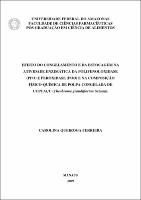| ???jsp.display-item.social.title??? |


|
Please use this identifier to cite or link to this item:
https://tede.ufam.edu.br/handle/tede/3709| ???metadata.dc.type???: | Dissertação |
| Title: | Efeito do congelamento e da estocagem na atividade enzimática da polifenoloxidase (PFO) e peroxidase (POD) e na composição físico-química de polpa congelada de cupuaçu (theobroma grandiflorum schum) |
| ???metadata.dc.creator???: | Ferreira, Carolina Queiroga  |
| ???metadata.dc.contributor.advisor1???: | Oliveira, Ila Maria de Aguiar |
| ???metadata.dc.description.resumo???: | O cupuaçu (Theobroma grandiflorum Schum.) está entre os frutos mais populares da Amazônia, sendo comercializado como polpa congelada pasteurizada ou não. Durante o processamento dos frutos o tecido vegetal torna-se escuro devido às reações catalisadas por enzimas oxidativas: peroxidase e polifenoloxidase, presentes naturalmente nos frutos atuando não somente na alteração da cor, mas também na degradação dos nutrientes, especialmente durante o armazenamento. O congelamento e a pasteurização são geralmente utilizados para minimizar os efeitos causados pela oxidação e eliminar parte dos microrganismos presentes nos frutos. Este estudo teve por objetivo avaliar as alterações físico-químicas e enzimáticas em três lotes de polpas congeladas de cupuaçu, provenientes de diferentes regiões, pasteurizadas e não pasteurizadas, armazenadas em temperatura entre -25ºC e -30ºC por um período de 12 meses. As análises físico-químicas foram realizadas a partir das Normas do Instituto Adolfo Lutz (2005) e as análises de polifenoloxidase e peroxidase, segundo método descrito por Oktay, M. et al. (1995) e Khan e Robinson (1994), respectivamente. Foi realizada uma análise estatística dos dados coletados segundo o modelo linear geral e através do teste ANOVA. Após o período de armazenamento observou-se que a procedência do lote, o tempo de armazenamento e a submissão ao processo de pasteurização exerceram influências significativas (1%, p<0,05) nos teores de sólidos totais, ácido ascórbico, acidez titulável e na atividade da peroxidase. Os açúcares foram influenciados de forma significativa (1%, p<0,05) pelo lote, pasteurização e tempo de estocagem, bem como pela interação do lote e da pasteurização. A polifenoloxidase nas amostras pasteurizadas e não pasteurizadas, em todos os lotes, apresentou variações durante os doze meses de armazenamento sob congelamento. |
| Abstract: | Cupuaçu (Theobroma grandiflorum Schum.) is one of the most popular fruit of Amazon. The pulp is commercialized in two forms: pasteurized or non pasteurized. During processing, the pulp becomes dark due to reactions catalyzed by oxidative enzymes: such as peroxidase and polyphenol oxidase. These enzymes are naturaly present in the fruit and causes alteration in its color, and also, in degradation of fruit nutrients, especially during the storage. Generally, freezing and pasteurization are used to minimize the effect caused by the oxidation reactions and to eliminate part of the microorganisms present in the fruit. The objective of this study was to evaluate the enzymatic alterations in three lots of frozen cupuaçu pulp, received from different regions, on pasteurized and non pasteurized forms and stored in between -25ºC and - 30ºC for a 12 months period. The physico-chemical analyses were carried according to Norms of the Instituto Adolfo Lutz (2005) and the analyses of polifenoloxidase and peroxidase, according to Oktay et al. (1995) and Khan and Robinson (1994), respectively. After one year of storage, it was observed that the source of each lot, the time of storage and the pasteurization processing show significant influences (1%, p<0,05) in total solid level, ascorbic acid content, titratable acidity and peroxidase activity. The source of each lot, the pasteurization processing, times of storage and the interaction between lot source and pasteurization processing showed significative differences (1%, p<0,05) on the sugars content. The polyphenol oxidases in the pasteurized and non pasteurized pulps, from the three lots, presented variations during twelve months of storage under freezing. |
| Keywords: | Frutas da Amazônia Enzimas composição química Amazonian fruit Enzymes Chemical composition |
| ???metadata.dc.subject.cnpq???: | CIÊNCIA E TECNOLOGIA DE ALIMENTOS: CIÊNCIA DE ALIMENTOS |
| Language: | por |
| ???metadata.dc.publisher.country???: | BR |
| Publisher: | Universidade Federal do Amazonas |
| ???metadata.dc.publisher.initials???: | UFAM |
| ???metadata.dc.publisher.department???: | Faculdade de Ciências Farmacêuticas |
| ???metadata.dc.publisher.program???: | Programa de Pós-graduação em Ciências de Alimentos |
| Citation: | FERREIRA, Carolina Queiroga. Efeito do congelamento e da estocagem na atividade enzimática da polifenoloxidase (PFO) e peroxidase (POD) e na composição físico-química de polpa congelada de cupuaçu (theobroma grandiflorum schum). 2009. 61 f. Dissertação (Mestrado em Ciência de Alimentos) - Universidade Federal do Amazonas, Manaus, 2009. |
| ???metadata.dc.rights???: | Acesso Aberto |
| URI: | http://tede.ufam.edu.br/handle/tede/3709 |
| Issue Date: | 31-Mar-2009 |
| Appears in Collections: | Mestrado em Ciência de Alimentos |
Files in This Item:
| File | Description | Size | Format | |
|---|---|---|---|---|
| Dissertacao Final Carolina Queiroga.pdf | 496.42 kB | Adobe PDF |  Download/Open Preview |
Items in DSpace are protected by copyright, with all rights reserved, unless otherwise indicated.




